
La leggenda di Sakùntala is a three-act opera by Franco Alfano, who wrote his own libretto based on Kālidāsa's 5th-century-BC drama Shakuntala. It was completed in 1920. When the score was believed lost in wartime bombing, Alfano reconstructed it, in 1945, now titling it simply Sakùntala, but in 2006 a copy of the original was found.

I Medici is an opera in four acts composed by Ruggero Leoncavallo, with a libretto by the composer. Set in Renaissance Florence at the court of Lorenzo de' Medici, it was intended as the first part of a planned but unfinished trilogy called Crepusculum. The opera premiered on 6 November 1893 at the Teatro Dal Verme in Milan.
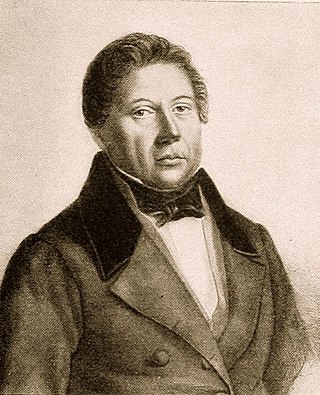
Le cantatrici villane is a comic opera in two acts composed by Valentino Fioravanti to a libretto by Giuseppe Palomba. It was first performed in Naples in 1799. A revised one act version premiered at the Teatro San Moisè in Venice as Le virtuose ridicole in 1801.
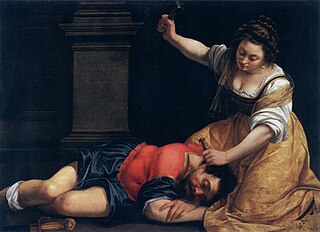
Dèbora e Jaéle is an opera in three acts composed by Ildebrando Pizzetti who also wrote the libretto. The libretto is based on the story of Deborah and Jael from the Book of Judges in the Bible. However, it differs in several ways from the traditional Biblical account, primarily in the motivations of its characters and the relationships between them. The opera was first performed at La Scala, Milan on 16 December 1922.

Antigone is an opera in three acts by Arthur Honegger to a French libretto by Jean Cocteau based on the tragedy Antigone by Sophocles. Honegger composed the opera between 1924 and 1927. It premiered on 28 December 1927 at the Théâtre Royal de la Monnaie with sets designed by Pablo Picasso and costumes by Coco Chanel.

Medea is an opera in three acts composed by Giovanni Pacini to a libretto by Benedetto Castiglia. It premiered on 28 November 1843 at the Teatro Carolino in Palermo, conducted by the composer with Geltrude Bortolotti in the title role. The libretto is based on the plays Medea by Euripides and Médée by Pierre Corneille.
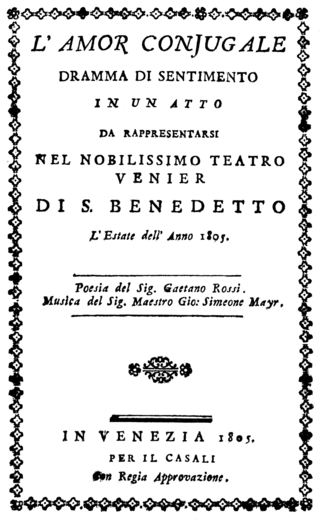
L'amor coniugale is an opera in one act by Simon Mayr set to an Italian libretto by Gaetano Rossi. It premiered at Padua's Teatro Nuovo on 26 July 1805.
Ginevra di Scozia is an opera in two acts by Simon Mayr set to an Italian libretto by Gaetano Rossi based on Antonio Salvi's Ginevra, principessa di Scozia, which in turn was adapted from cantos 5 and 6 of Ludovico Ariosto's Orlando Furioso. Ginevra di Scozia premiered on 21 April 1801 at the Regio Teatro Nuovo in Trieste to celebrate the inauguration of the new theatre. The story is virtually identical to that of Handel's Ariodante which shares the same source for the libretto.
La Lodoiska is an opera in three acts by Simon Mayr to an Italian libretto by Francesco Gonella De Ferrari. It was Mayr's second opera and premiered at La Fenice in Venice on 26 January 1796.

Didone abbandonata is an opera in three acts composed by Domenico Sarro to a libretto by Pietro Metastasio of the same name which was based on the story of Dido and Aeneas from the fourth book of Virgil's Aeneid. The opera premiered on 1 February 1724 at the Teatro San Bartolomeo in Naples.

Giacomo Vaghi was an Italian opera singer who had an active international career from 1925-1956. Along with Tancredi Pasero and Ezio Pinza, he was one of the leading operatic basses of his generation. He possessed a rich voice with a dark timbre that drew him particular acclaim in the operas of Giuseppe Verdi. He appears on several complete opera recordings made with EMI Classics and Cetra Records.

Rito Selvaggi was an Italian composer, pianist, conductor, poet, and educator. He composed numerous works, including operas, oratorios and sacred music as well symphonic and chamber music. He also served as the Director of the music conservatories in Palermo, Parma, and Pesaro.

La rosa bianca e la rosa rossa is an opera in two acts composed by Simon Mayr to an Italian libretto by Felice Romani. It premiered at the Teatro Sant'Agostino, Genoa, on 21 February 1813. Set in England against the backdrop of the Wars of the Roses, Romani's libretto is based on René-Charles Guilbert de Pixérécourt's La rose blanche et la rose rouge. Mayr's opera has also been performed under the title Il trionfo dell'amicizia.

Sì is an operetta in three acts composed by Pietro Mascagni to a libretto by Carlo Lombardo with verses by Arturo Franci. The libretto is based on Lombardo's operetta La duchessa del Bal Tabarin and Felix Dörmann's libretto for Majestät Mimi set by Bruno Granichstaedten in 1911. Mascagni's only venture into operetta, it premiered on 13 December 1919 at the Teatro Quirino in Rome. The operetta takes its name from its central character, Sì, an actress at the Folies Bergère, so called because she could never say no.
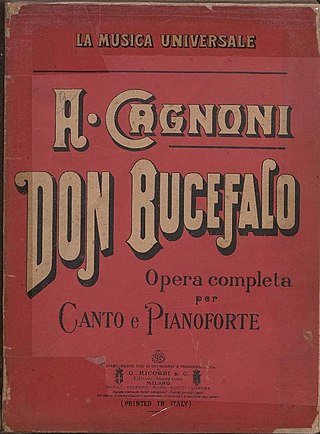
Don Bucefalo is an opera in three acts composed by Antonio Cagnoni to a libretto by Calisto Bassi. Bassi's libretto was based on the libretto by Giuseppe Palomba to Le cantatrici villane (1799) by Valentino Fioravanti. Don Bucefalo premiered on 28 June 1847 at the Milan Conservatory.
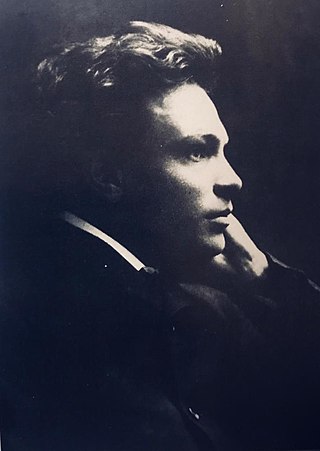
La bella dormente nel bosco is an opera in three acts by Ottorino Respighi to a libretto by Gian Bistolfi based on Charles Perrault's fairy tale "Sleeping Beauty".

Il bravo, ossia La Veneziana is an opera in three acts by Saverio Mercadante to an Italian-language libretto by Gaetano Rossi and Marco Marcello. Their libretto was based on the play La Vénétienne by Auguste Anicet-Bourgeois, which was in turn based on James Fenimore Cooper's novel The Bravo. The opera premiered on 9 March 1839 at La Scala, Milan and subsequently played throughout Italy and abroad. The opera was still being occasionally performed and recorded in the 20th century. and was hailed as an "exciting rediscovery" when it was staged by the Wexford Festival in 2018.

Maria Carbone was an Italian operatic soprano. She created the lead female roles in two of Gian Francesco Malipiero's operas: the title role in Ecuba and Cleopatra in Antonio e Cleopatra.
Nitocri is an opera in two acts composed by Saverio Mercadante to libretto by Apostolo Zeno adapted by Lodovico Piossasco Feys. The libretto is a fictionalised account of the Egyptian queen Nitocris. The opera premiered at the Teatro Regio in Turin on 26 December 1824.















